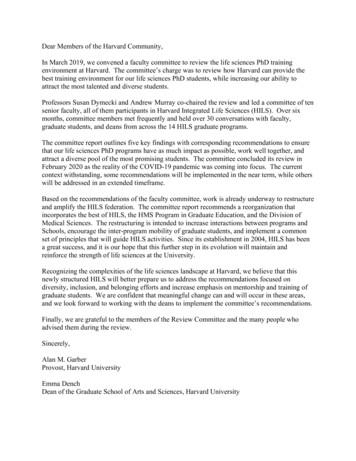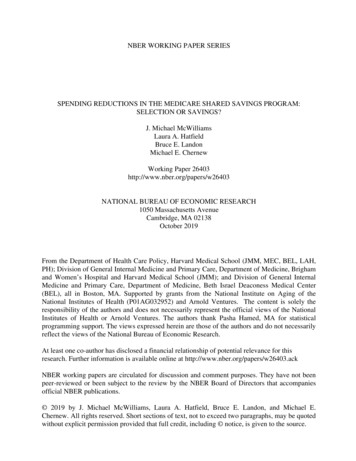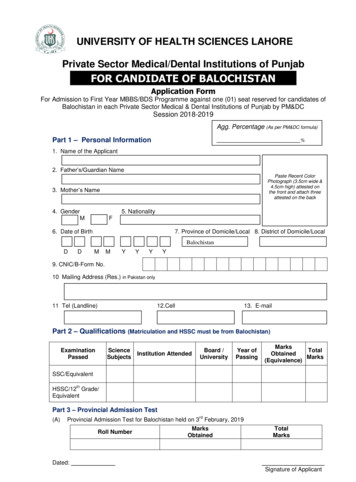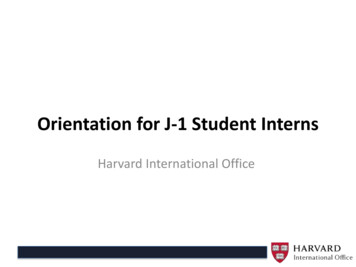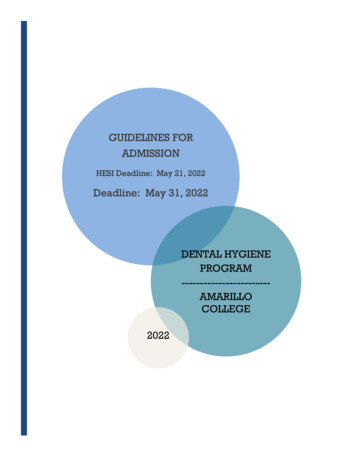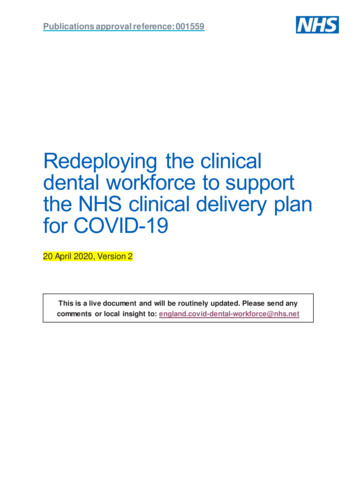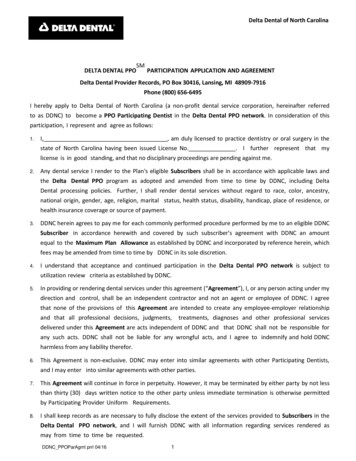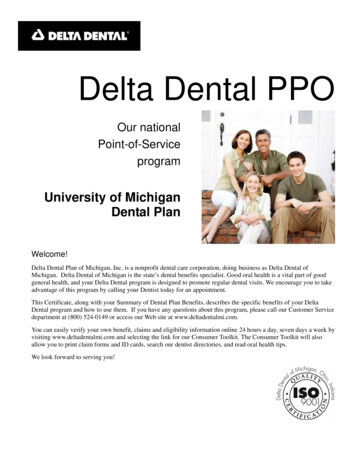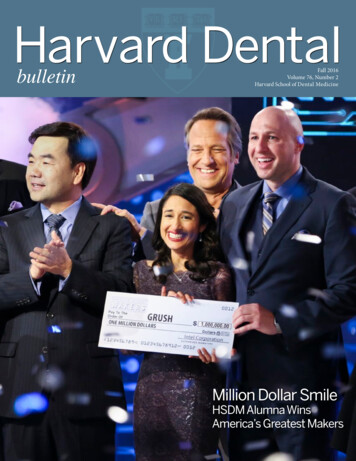
Transcription
HarvardDentalbulletinFall 2016Volume 76, Number 2Harvard School of Dental MedicineMillion Dollar SmileHSDM Alumna WinsAmerica’s Greatest Makers
HarvardDentalbulletinFall 2016 Volume 76, Number 2Harvard School of Dental MedicineFeatures1 Letter from the Dean2 New Study by HSDM Researchers May HaveImplications for Treating Osteoporosis4 Million Dollar Smile6 HSDM Celebrates 2016 Graduates7 A Warm Welcome and White Coats for theClass of 2020Faculty Highlight8 Fulbright Scholar Dr. John Ahern10 HSDM to Lead Program in Rwanda on EthicsTraining in Health Research11 New Center Will Address the Oral HealthCompetency Gap in Primary Care Training12 Reunion RecapDrs. Adam Hamilton, lecturer on Restorative Dentistry andBiomaterials Sciences; Giuseppe Intini, assistant professor ofOral Medicine, Infection and Immunity; and Yingzi Yang,professor of Developmental Biology; went to Chengdu,China for a week this summer to teach dental students in aninternational dental student summer camp at the WesternChina School of Stomatology. See page 19.14 Gift of 50,000 Kicks Off the Freeman, Grant,Franklin Scholarship16 New State-of-the-Art Classroom Takes Root17 Upcoming Events18 Harvard Dental BitesAlumni NewsHSDM AwardsHSDM News21 From the ArchivesCover photo:Team Grush on America’s GreatestMakers (photo by Tommy Baynard/Intel Corporation)The Harvard Dental Bulletin is publishedtwice a year for alumni and friends ofHarvard School of Dental Medicine.We look forward to receiving yourfeedback and news.Please send correspondence to:Harvard Dental BulletinHarvard School of Dental Medicine188 Longwood AvenueBoston, MA 02115Email: bulletin@hsdm.harvard.eduPhone: 617-432-2072HSDM Office of Development andAlumni RelationsWanda Mock, Associate DeanCopyright 2016President and Fellows of Harvard CollegeVisit HSDM’s websitewww.hsdm.harvard.eduSocial MediaFollow HSDM on Facebook, LinkedIn,YouTube, and Instagram for news andupdates.Produced by: HSDM Office ofDevelopment and Alumni RelationsSenior Editor: Heather M. DennyDesign: Glenn Ruga/VisualCommunicationsWriting: Heather M. Denny,Ellen GarnettEditorial Committee: Dawn DeCosta,Amy Fenton, Wanda Mock, Lia SgourakesPhotography: Steve Gilbert, SteveLipofsky, Tommy Baynard/IntelCorporation, Tony RinaldoPrinting: Puritan Press
FROM THE DEANDear Alumni and Friends,One of my favorite traditions of theacademic year is having the honorof welcoming thirty-five new DMDstudents to the Harvard School ofDental Medicine. In an orientation eventheld in early August, we met these exceptionalstudents who have come here from all over thecountry to pursue their dreams of degrees in dentalmedicine. The incoming class, selected from morethan 1,000 applicants, includes 21 women and 14men representing 19 states and 27 different undergraduate institutions.These students are already quite accomplished.As undergraduates they studied biology, biomedical science, chemistry, economics, global health,and neuroscience, among other majors, and manygraduated in the top of their class. However,perhaps even more impressive is the great numberof them who have served as volunteers, tutors andmentors. One devoted his time to working withchildren with autism, while another served as ahome hospital teacher who created lesson plans forkids with chronic diseases. Yet another mentoredrefugee students, helping them adapt to Americanculture, and another volunteered with an organization that exposes elementary school girls to STEMfields. Many have also led outreach and servicetrips to countries around the world such as Bolivia,Chile, Ecuador, Fiji, Honduras, Panama, and Peru.And several have worked as research assistants,and lab technicians; some even publishing theirfirst academic papers.They come to HSDM full of promise and eagerto learn. They are here at a momentous time in theSchool’s history. In 2017, we will celebrate our 150thanniversary. As the first dental school connectedto a university and its medical school, we’ve ledthe way in dental education, research, and clinicalcare. All of this has been accomplished thanks toour predecessors who had the foresight to createthis great institution, and our remarkable alumniwho have gone on to make an impact in dentistryand many other fields. Alumni such as AnubhaSancheti, DMD05, profiled in this issue of theBulletin, a pediatric dentist who is an advocatefor children, as well as an author, inventor, andentrepreneur. She’s quoted in the article as saying,“HSDM never limited me to one path—that wasthe beauty of my learning there.”This is true, and worth reiterating. As manyof you, our alumni, have gone on to pursuediverse paths within dental medicine, but alsoin many other fields such as academia, business,government, public service, and more. During ouranniversary year, I hope many of you will return tocampus to join us in celebrating your accomplishments that have become part of the rich history ofthis school.To our new DMDs—may you know no boundsin your educational and personal pursuits. I lookforward to seeing how you too will make yourmark on history.Bruce Donoff, DMD67, MD73Fall 20161
Harvard Dental BulletinRESEARCH FOCUSNew Study by HSDM ResearchersMay Have Implications forTreating OsteoporosisADr. Roland Baron(left) and Dr.Francesca Gori(right) studied askeletal geneticdisorder to gaininsights onosteoporosis.s we age, every stumble or fall comeswith a risk—a risk that is even greater forthose ten million people in the U.S. who haveosteoporosis, a skeletal disease characterizedby low bone mass, poor bone quality andfractures. Each year, 1.5 million bone fractures areattributed to osteoporosis, including 350,000 hipfractures. But hip or other fractures in older and osteoporotic patients do not heal easily and this often leads tosignificant impairments in daily life, and even death.Dr. Roland Baron, professor andchair of the Department of OralMedicine, Infection and Immunityat the Harvard School of DentalMedicine (HSDM), Division of Boneand Mineral Research, and professor ofMedicine at Harvard Medical School(HMS), and his research team collaborated with the research team of Dr.Superti-Furga, professor of pediatrics at the Universityof Lausanne in Switzerland, to study cortical bonefragility. Cortical bone is the hard outer layer of bone2Fall 2016that becomes more susceptible to fracture in peoplewith osteoporosis. Their findings, recently publishedin The New England Journal of Medicine in the article“Cortical-Bone Fragility — Insights from sFRP4Deficiency in Pyle’s Disease,” may shed light on thecauses of and potential treatment for cortical-bonefragility.Studying genetic disordersof the skeleton can often leadto greater insights on commonskeletal ailments such asosteoporosis. Dr. Pelin SimsekKiper from the University ofLausanne and Drs. Hiroki Saitoand Francesca Gori, assistantprofessor of Oral Medicine, Infection and Immunity,from HSDM (co-first authors) studied Pyle’s disease,a human genetic disorder characterized by increasedamounts of trabecular bone, cortical bone thinningand limb deformity, and identified a recessive geneticmutation in SFRP4, a Wnt signaling inhibitor, thatcauses the disease. The team reproduced the genetic
From the LabHSDM Researchers ReceiveNIH-NIAMS R01 Awardsdeletion in mice and demonstrated that trabecularand cortical bone compartments are differentiallyregulated and that proper crosstalk between Wnt andBmp signaling is critical for cortical bone homeostasis.In addition, the team experimented with reversingthe effects of SFRP4 deficiency in mice with pharmacologic treatments. Interestingly, specific treatmentssignificantly improved bone mineral density, andcorrected the cortical-bone defect.“One of the most interesting aspects of our findingsis the demonstration that the regulation of trabecularbone, the main component of vertebrae, and of corticalbone, predominant in long bones like the hip or wrist,differs to some degree,” Dr. Baron said. “This may helpexplain why some drugs are very efficient in preventing vertebral fractures but not so good for hip fracturesand may open a new avenue for research, ultimatelyrefining our diagnostic and therapeutic approaches.”The team’s findings also highlighted limitations ofthe most commonly used tools for the diagnosis andevaluation of skeletal diseases, which often cannotproperly distinguish these two bone compartments.“Our studies provide important insights and reasons to explore how Wnt and Bmp signaling regulatebone mass differentially in trabecular and corticalbone. This may offer a platform to further understandWnt signaling specificity, and to tease out its multipleroles in skeletal development and homeostasis,” Dr.Gori said.Ionescu Investigates Osteoarthritis forDrug TreatmentAbout the Baron LaboratoryDr. Yingzi Yang, professor ofDevelopment Biology, receivedfunding from NIH-NIAMS forher R01 project, “Gas-HedgehogSignaling in Intramembranous BoneFormation and Expansion.”Her research will build upon the Yang Lab’s recentdiscovery of a Gas-Hedgehog (Hh) signaling axisthat plays a crucial role in the molecular and cellularregulation of bone development. Dr. Yang will investigate her central hypothesis, “Gas-Hh signaling axis isrequired to regulate osteoblast differentiation duringintramembranous bone formation and recruit wildtype cells int the ectopic bone during progressiveosseous heteroplasia,” according to the abstract.The goal of Dr. Yang’s research project is to provide insight into the regeneration of organ systemsand increase the understanding of the Gas-Hh andGas-Wnt signaling pathways in human diseases,such as cancer.The Baron Laboratory at HSDM focuses on signaltransduction and the ways in which it controls bonecell differentiation and function. Members of the labstudy primarily skeletal development and remodelingas a model system. This work combines in-vitro andin-vivo experiments—often involving genetically modified transgenic or knockout mice and their isolatedcells—that integrate molecular, cellular, and in-vivostudies to determine both the molecular mechanismsof cell biology and pathology and the impact of thesemechanisms and their alteration at the organ levelin normal and disease conditions. This research isdirectly relevant to several medical issues, includingosteoporosis, osteoarthritis, bone metastasis in cancerand endocrine disorders of calcium and phosphatemetabolism.Dr. Andreia Ionescu, instructor inDevelopmental Biology, receivedfunding from the National Institutesof Health National Institute ofArthritis and Musculoskeletal andSkin Diseases (NIH-NIAMS) forher R01 project, “Hypertrophy and Inflammation inOsteoarthritis: Epistasis or Synergy?”Her research project will focus on articularcartilage development in relation to osteoarthritis(OA), which is a degenerative joint disease thatcurrently has no cure. In her previous research at theDepartment of Biological Chemistry and MolecularPharmacology at Harvard Medical School, Dr. Ionescufound a new family of transcription factors (FoxA)that are essential for cartilage growth. Dr. Ionescuwill further study the function of FoxA factors, “aspotential regulators of articular cartilage hypertrophyand OA progression in both human OA and a murinemodel of this disease,” according to the abstract.Ultimately, the goals of the research are toestablish a basis for osteoarthritic drug developmentand to increase the understanding of pathogenicmechanisms involved in OA onset to target withpharmacological intervention.Yang Leads Research on BoneDevelopmentFall 20163
Harvard Dental BulletinALUMNI PROFILEMillion Dollar SmileHSDM Alumna Wins America’s Greatest MakersAnubha Sacheti,DMD05, PD06(center) with herbusiness partnersin Grush–YongjingWang (left) andEthan Schur (right).On May 24, 2015, Anuba Sacheti, DMD05,PD06 stood beneath the bright lights of atelevision sound stage with confetti swirlingaround her, and a studio audience cheering.The pediatric dentist and her partners had justwon a 1 million on the reality show America’s GreatestMakers for their invention, Grush.“I did not think we were going to win. I felt like MissAmerica up there,” Sacheti said.Sacheti and her team beat thousands of competitorswho auditioned for the TBS reality show to make it tothe round of 23 finalists, and to ultimately capture thegrand prize. Their product, Grush, is an interactive digital toothbrush that uses Bluetooth and GPS technologyto transform how kids brush their teeth. Children usethe Grush toothbrush paired with an app to play a seriesof fun virtual games on a smartphone while brushingtheir teeth. Grush also allows adults to digitally trackbrushing habits.4Fall 2016The concept of making it fun for kids to brush isnear and dear to Sacheti’s heart. She first discoveredthat she loved working with kids, especially those inunderprivileged communities, through her GeneralPractice Residency at Cambridge Health Alliance whileat HSDM. Today, she continues to practice several daysa week in Fitchburg, Massachusetts. She is also theco-author of the book Happy, Healthy Teeth! A Guide toChildren’s Dental Health.Sacheti’s own young girls, ages five and eight, werealso an inspiration for the product.“As a dentist, I have been committed to preventingtooth decay, a common chronic disease among children.As a mother, I wanted to help end the ‘battle in thebathroom’ over brushing,” she said.She partnered with West Coast video game entrepreneurEthan Schur and inventor Yongjing Wang on their initialidea for the product. She evaluated Grush from a dentalperspective and joined the team as Chief Dental Officer.
Dentist to reality star1,000s“The Bluetooth and GPS work with sensors thatunderstand tooth by tooth where kids are brushing.”There is also a patented algorithm working behind thescenes to translate the data. “That’s why it’s so differentthan what other manufacturers are doing,” she said.She explained that if a child is constantly missing aparticular spot time after time, Grush will show thatdata. “The goal is to capture the data in the dental chartso we can watch over time how the children are brushing,” she added.Sacheti says it is her dream to put Grushtoothbrushes in the hands of underprivilegedchildren who might not have someone at homewho is able to help them brush.As for what she and her team will do with the milliondollar prize, Sacheti says they are currently lookingfor a manufacturer. Once they find one, they will usethe money to mass produce Grush. They hope to haveGrush in stores as early as Black Friday for holidaysales. Ultimately she says it is her dream to put Grushtoothbrushes in the hands of underprivileged childrenwho might not have someone at home who is able tohelp them brush.Sacheti has been a longtime advocate for children.She serves as secretary of the Massachusetts Academy ofPediatric Dentistry and the national AAPD Council onGovernment Affairs and was Massachusetts State Leaderfor the Dental Head Start Program. From her experience on America’s Greatest Makers, she hopes to inspireyoung girls who want to be inventors or entrepreneurs.Sacheti also has advice for today’s HSDM students,“Dentistry is one path, but not the only path. Thereare other things you can do with your training. HSDMnever limited me to one path–that was the beauty of mylearning there,” she said.Audition for the first national casting ofAmerica’s Greatest Makers, a new TBSreality show23Finalists fly to California to pitch theirhigh tech ideas to a panel of businessexperts and celebrities including Mike Rowe,Kenny Smith, Brian Krzanich, MassimoBanzi, Shaquille O’Neal, Mayim Bialik, andCarol RothTop remaining teams continue to refine theirproducts. The final five each win 100,000The final five put the finishing touches ontheir products and battle for the prize of 1,000,000Grush Team wins final prize!Grush fine tunes product toget ready for mass productionGoal:10,000Units on the shelves by Black FridayFall 20165
Harvard Dental BulletinSTUDENT FOCUSHSDM Celebrates2016 GraduatesHarvard Commencement and Class DayAbove: The Classof 2020 poses fora group photo inHarvard Yard.was held on Thursday, May 26 with celebration and ceremony. The day began with thegraduating students marching into Harvard’sTercentenary Theatre for Morning Exercises.Music, tradition, and remarks by students and deanscommemorated the 375th Commencement.Degree candidates from 13 schools and HarvardCollege were recognized by school and cheered by thecrowd. Harvard School of Dental Medicine (HSDM)awarded 61 degrees—13 Master of Medical Sciences,12 Doctor of Medical Sciences, 36 Doctor of DentalMedicine degrees.Later in the day, HSDM students joined theirHarvard Medical School classmates for Class Day onthe HMS Quad. Family and friends gathered to hearspeeches by student speakers and the deans of bothschools. Their remarks touched on partnerships andtransition.“You will be great dentists and exceptional oral physicians. You have learned to appreciate that patients areunique, and by your education here, you will be doctorswho understand the complex and deep relationshipbetween oral health and the health of the whole body.Your achievements should make you very proud,” saidDean Bruce Donoff, DMD67, MD73.Student speaker Daniel Brein, DMD16, encouragedhis classmates to trust their instincts as they transitionRight, top: DeanBruce Donoff,DMD67, MD 73addressesgraduates atClass Day.Right, bottom:AGE graduatestake a selfie whilewaiting to marchinto TercentenaryTheatre.6Fall 2016from their student lives to careers. “Your naturaltendencies toward curiosity, innovation and leadership,with equal parts empathy, community, and kindnesshave carried you far,” Brein said. “And while the futureis full of unknowns, if you continue to trust in and listento yourselves, nothing will be out of reach.”“And while the future is full of unknowns, ifyou continue to trust in and listen to yourselves, nothing will be out of reach.” —Daniel Brien, DMD16After the remarks the graduates received their diplomas and hoods. They joined their families, and HSDMfaculty and staff for an Alumni Reception honoringHSDM’s newest alumni.
A Warm Welcome and WhiteCoats for the Class of 2020During the first week of August, HarvardSchool of Dental Medicine (HSDM) welcomeda new class of Doctor of Dental Medicine(DMD) students. The Class of 2020 is madeup of 35 talented individuals who were chosenfrom more than 1,000 applicants.The new dental students participated in orientationevents throughout the week, along with their HarvardMedical School (HMS) classmates. On the morning ofTuesday, August 2, they were addressed by acting HMSDean, Barbara McNeil, MD66, PhD72 and HSDMDean Bruce Donoff, DMD67, MD73.“You come here at a wonderful time in the historyof medicine,” McNeil said as she welcomed the 200members of the HMS and HSDM Class of 2020. “Thereis no better place to do work in the fields you’ll beworking in, than the community you’ll find here.”Dean Donoff echoed McNeil’s sentiments and spokeabout the importance of oral health as a vital part ofprimary care.“I call Harvard an unconventional dental school,”Donoff said. “Today, the fact that you medicaland dental students begin your journey togetheremphasizes that Your education for lifelong learningand helping people begins today.”After initial introductions, the students had lunchwith their academic societies and tried on theirwhite coats for the first time. They also met HSDMsenior tutors Samuel Coffin, PD80, Cannon Society;Armando Pardo, DMD15, Castle Society; MahaAlmusa, Holmes Society; and Aram Kim, DMD11,Peabody Society.“Your education for lifelong learning andhelping people begins today.”—Dean Bruce Donoff, DMD67, MD73The week concluded with the Dean’s White CoatCeremony on Friday, August 5, held on the HMSQuad. Surrounded by family and friends, studentstook the stage one at a time to introduce themselves.Donning their white coats, a symbol of their commitment to learning the art and science of medicine,they pledged the HMS/HSDM Class of 2020 Oath.The Oath reminds the future dentists and doctors to“Breathe together, watch together, be together andpause,” as they embark on the rigorous academicjourney ahead.Following the ceremony, a special tea was held atHSDM in honor of the new DMD students and theirfamilies.Fall 2016Above: Inwelcoming theHSDM and HMSclass of 2020, DeanDonoff, DMD67,MD73 emphasizedthe link betweenoral health andgeneral health.Left, top: JennieMarinucci, DMD20,receives her whitecoat from ArmandoPardo, DMD15 tobegin her journey atHSDM.Left, bottom: Theclass of 2020 wasdelighted to receivetheir white coats.7
Harvard Dental BulletinSCHOLAR PROFILEFulbright Scholar Dr. John AhernImproving access to health services by expandingoral health clinical competencies for frontline primarycare cliniciansFulbright ScholarDr. John Ahern atHSDM.Dr. John Ahern joined HSDM in Julyas a Fulbright Scholar from Dublin,Ireland. Dr. Ahern received both hisdental (2010) and medical (2015) degreesfrom Trinity College Dublin, and hismasters in public health from the London Schoolof Hygiene and Tropical Medicine (2013). He hasworked as a dentist and physician and completedan internship at the World Health Organization’s(WHO) Department of Oral Health in Geneva,Switzerland. As a well-rounded healthcare professional, Dr. Ahern is passionate about the promotion of oral health through inter-professionalcollaboration and communication with otherhealth professionals. We asked him about what ledhim to HSDM, his role as a Fulbright Scholar, andhis goals for the future.8Fall 2016Can you tell us why you decided to pursue anDMD/MD, and why you have chosen to focusyour research on public health & primary care?When I was working in the Dublin Dental UniversityHospital, I was introduced to an impressive group ofdual-qualified clinicians. As I was based primarily in theemergency department, I worked very closely with them,and it was a fantastic learning experience for me. Theirlevel of knowledge, array of skills, and capacity to provideleadership to both oral and general health professionals,really inspired me to pursue dual-qualification.In the years thereafter, I had somewhat of adual-identity as a health professional. I continuedto work part-time as a dentist in both hospital andcommunity settings, while also training as a medicaldoctor. By working in both professions concomitantly,I was afforded a relatively unique position, whichallowed me to identify a massive opportunity for the
integration of oral health competencies within the skillset of other health professionals, especially primarycare clinicians.Why did you want to come to the HarvardSchool of Dental Medicine (HSDM)?Well, all you have to do is look at HSDM’s mission statement to see why it is such a privilege for me to be hereas a Fulbright Scholar. My initial contact with HSDMcame in 2014, when I was on an elective in Brigham &Women’s Hospital. A few different U.S. and Irish sourceshad introduced me to Jane Barrow through email. Wegraciously conceded that the universe must be tellingus something, and arranged to meet over coffee. Janewas full of ideas as to how we could work together tosupport each other’s mutual goals, and I was confidentthat I would fit in very well with the research activitieshere at HSDM.I was also introduced to Dean Donoff, who was apowerful source of encouragement to pursue this goal,and being a dual-qualified clinician himself, he provedto be a real source of inspiration for me to come toHSDM. Now that I am here, I see this as a new chapterfor me, and I hope to build lasting relationships atHSDM, both personal and professional, and createopportunities to build on these relationships long intothe future.How did you decide to apply for a Fulbrightscholarship, and what does it mean to be aFulbright scholar at HSDM?When I returned to Ireland after that visit to Boston, Iwas updating one of my professors at Trinity Collegeabout my recent activities at the WHO, and telling himmy goals for the future, which involved working withHSDM. He sat back in his chair, put his arms behind hishead, and just when I thought he was going to tell meto get real and stop wasting my time, he leaned forwardand said, “John, this is a fantastic idea, and it screamsFulbright.”The Fulbright program is a very well-known scholarship internationally, and carries a lot of prestige, whichwas very helpful to me when promoting the idea of oralhealth integration among primary care clinicians. Atfirst, this idea was getting mixed messages from bothmedical and dental audiences. I was even told by onemedical doctor at a conference in England that the ideaI was promoting was “very controversial.”So winning the support of the Fulbright programwas a hugely significant milestone for me, as it provideda platform to promote this idea on a larger scale and toa broader audience. It also encouraged people to listenmore attentively to the principles behind the research,and it certainly fostered a greater interest from important stakeholders.What are your impressions of Boston andHarvard so far, and outside of work, how do youlike to spend your time?Well firstly, the people here have been so welcoming. Ofcourse, I’ve learned that having an Irish accent helps, soI’ve no intention of trying to dampen that down.The students and staff here are refreshingly confidentand driven. To be ambitious, and to want to make adifference is really admired and encouraged here atHarvard, and it is a real privilege to be part of thatculture.Outside of work, I am a sports and fitness enthusiast.In my free time, I love to exercise and be outdoors.In fact, I’m running the New York City marathon inNovember for the Miles for Miracles charity at BostonChildren’s Hospital. Boston is such a beautiful trainingground for a marathon, and it has been a wonderful wayto see the city so far. After exercising, I do love my foodand drink, and being a huge sports fan, too, Boston hasme spoiled for choice with great venues to sit back andindulge these interests.Fall 20169
Harvard Dental BulletinGLOBAL FOCUSHSDM to Lead Program inRwanda on Ethics Training inHealth ResearchBy Ellen GarnettDr. Bernard Friedland,assistant professorin Oral Medicine,Infection andImmunity, recentlyreceived a National Institutesof Health (NIH) FogartyInternational Center Awardfor his research project,“Development Initiative for Ethical Review andOversight of Health Research Involving Human Subjectsin Rwanda.”Harvard School of Dental Medicine (HSDM)was one of four schools to receive NIH grantsfor projects which will foster global healthresearch.HSDM’s Dr. Friedland will lead the project asPrincipal Investigator to pursue an internationalcollaboration with the University of Rwanda. Throughthis partnership, the goal is to establish in Rwanda a“self-sustaining, well-functioning national system ofethical review in [health research] within five years,”according to the abstract.“We don’t want to impose the American system onthem,” said Dr. Friedland. In fact, Rwanda is alreadyrecognized as a healthcare leader in the region withits initiative to organize a universal healthcare system.According to Dr. Friedland, a national system of ethicalreview would allow low and middle income countries(LMICs) like Rwanda to become more independent ofWestern influence by being able to respond to their ownresearch needs.In recent years, Rwanda has established a NationalEthics Committee (NEC) and has various Institutional10Fall 2016Review Boards (IRBs) to monitor human research.The project, which is in partnership with the HumanResources for Health (HRH) consortium, intends tobuild upon the ethics training in both the U.S. andRwanda to design standards for an autonomous systemof ethical review.The aim is to train 140 Rwandan researchers to:1) conduct ethically responsible research, 2) becomeresearch ethics trainers of the next generation, 3)develop, implement and monitor ethics review policiesand procedures, and 4) become the leaders who shaperesearch ethics education, policies and priorities for thenation and region.Dr. Friedland pointed out that there are certaindiseases which are more prevalent in other parts ofthe world, such as the 2014 Ebola outbreak in WestAfrica. Outbreaks such as this demonstrate the breadthof health disparities that require a system of ethics inresearch to protect already vulnerable populations.In addition to his dental and radiology training,Dr. Friedland has a law degree and is one of only a fewdentists in the American College of Legal Medicine. Hewill collaborate with two other key investigators on theproject. They include Nir Eyal, PhD, associate professorof Global Health and Social Medicine at HMS; GlobalHealth and Population at the Harvard T.H. Chan Schoolof Public Health; and Program in Ethics and Health atHarvard University; and Aline Umubyeyi, MD, PhD,faculty researcher at the University of Rwanda Collegeof Medicine and Health Sciences School of PublicHealth.Work has already begun on recruiting Rwandanparticipants and on the development of curriculum for aone week course in September on ethics training.
New Center Will Address theOral Health Competency Gap inPrimary Care TrainingThe Harvard School of Dental Medicine incollaboration with Harvard Medical School(HMS) and University of MassachusettsMedical School was awarded a five-year, 3.5million dollar cooperative agreement grantfrom the Health Resources and Services Administration(HRSA) to establish a Center for Excellence for OralHealth Integration into Primary Care Training that willconvene experts in family medicine, general medicine,geriatrics, pediatrics, and oral health to address the oralhealth competency gap in primary care training.The Center will focus on oral health disparitiesin vulnerable and underserved populations, such aschildren, the elderly, disabled, mentally ill, and specialneeds populations, by engaging frontline primary carehealth professionals
The Harvard Dental Bulletin is published twice a year for alumni and friends of Harvard School of Dental Medicine. We look forward to receiving your feedback and news. Please send correspondence to: Harvard Dental Bulletin Harvard School of Dental Medicine 188 Longwood Avenue Boston, MA 02115 Email: bulletin@hsdm.harvard.edu Phone: 617-432-2072


